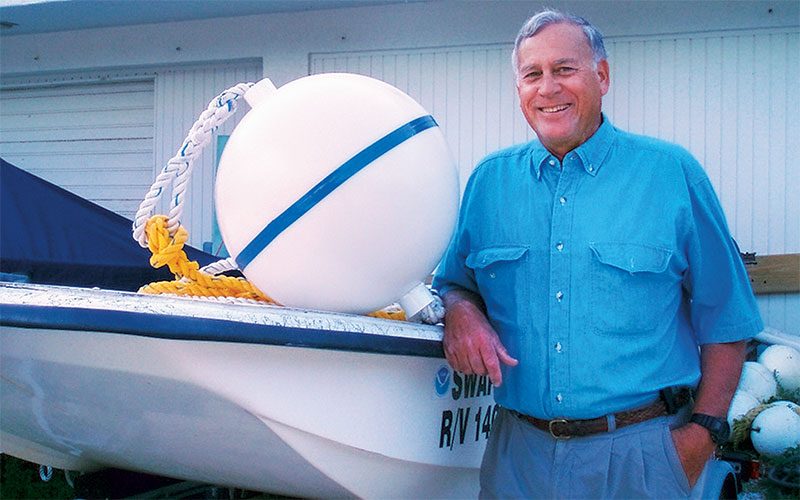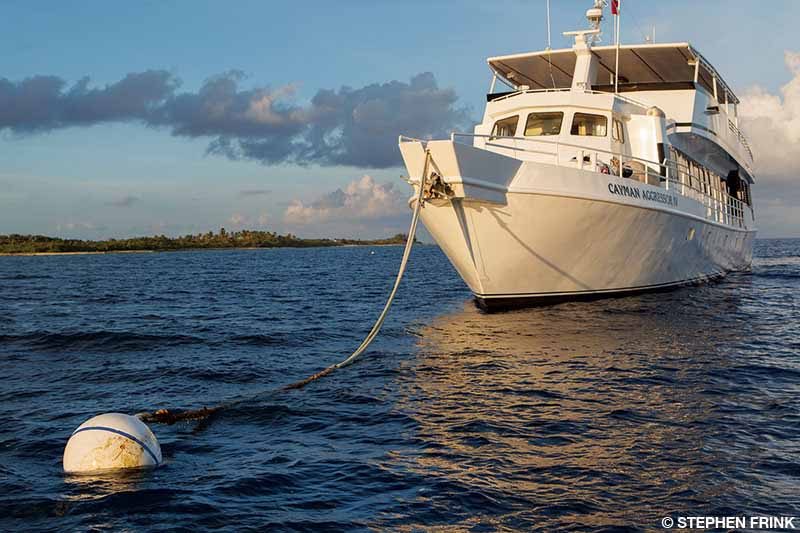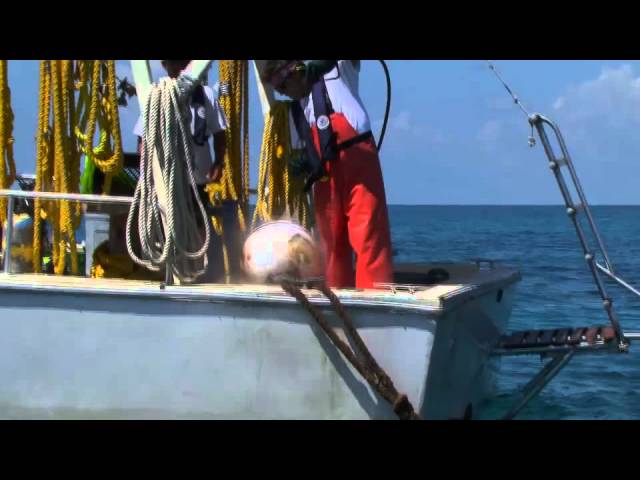A system anchored in Florida Keys history
Mooring buoys minimize the impact on the environment and protect fragile coral animals and nonrenewable historical resources from anchor damage. If you have ever tied to a mooring buoy, you can thank John C. Halas. Halas, a marine biologist, was one of the National Marine Sanctuary Program’s first employees.
Halas had graduated from Florida State University (FSU) in 1964 with a marine biology degree and became a certified science diver. After serving his country in the U.S. Army during the Vietnam War, he returned and worked for a mariculture company in Marathon, Florida, before being accepted into the unique FSU Scientist-in-the-Sea graduate program conducted at the Naval Coastal Systems Lab in Panama City. He worked for two years as a marine science technician with the Harbor Branch/Smithsonian field station based at John Pennekamp Coral Reef State Park until the station closed in 1975.
Halas’ love of diving led him to share a partnership in a Key Largo dive business with Gary Rinn, a well-known member of the dive community who created the Keys Association of Dive Operators (KADO), the first organized forum for Florida Keys dive shop operators.

In 1980 Halas accepted a position as a marine biologist and acting manager of the Key Largo National Marine Sanctuary, the 103-square-nautical-mile protected area established in 1975 and administered by the National Oceanic and Atmospheric Administration (NOAA) adjoining the seaward boundary of Pennekamp State Park. His degree, advanced diving skills and extensive knowledge of the Florida Keys underwater environment perfectly qualified him for the position at the newly established sanctuary. Halas’ early experience in the dive industry helped him to recognize the parallel between protecting the resources that visitors enjoy and the impact that anchoring was having on the economically and culturally valuable environment. This revelation led Halas to develop the mooring buoy system we know today: an embedment anchor connected to an 18-inch round, white, floating buoy with blue reflective tape around the middle with a yellow polypropylene pick-up line.
The first real-world test of the system happened in 1981 at Key Largo’s French Reef, a frequently visited location. The United States Geological Survey (USGS) Fisher Island Station’s director Eugene Shinn lent extensive support to the project. The USGS supplied the boat, hydraulic drilling equipment, coring bits and cement, and USGS staffers Harold Hudson and Dan Robbin provided their expertise and extensive experience during installation of the first six experimental buoys.

The test was successful, and the dive community and residents readily adapted to using the new mooring buoy system. Today the Florida Keys National Marine Sanctuary offers 490 mooring buoys and supports an additional 300 regulatory marker buoys throughout its 3,800-square-mile jurisdiction. To learn more about the sanctuary’s buoys and view their locations, visit floridakeys.noaa.gov/mbuoy/allmbuoys.html.
Management of those buoys falls to the trained staff at Florida Keys National Marine Sanctuary. Installation of a permanent embedment anchor in hard coral limestone and soft sand sediment requires two distinct sets of tools, special techniques and ground tackle. In the hard limestone sea bottom, removing a core followed by installing a pin became the method used. Installers cement a pin into the void created by a coring bit. After the cement sets, a shackle with a surface line is attached to the eyehole. Local Key Largo welder Gordon Cottrell assisted in designing the pin. The prototype was an 18-inch, stainless-steel rod with a short T welded on one end and a welded eyehole on the other. A shackle with a surface line is attached to the eyelet.
Areas with soft sediment required a different anchoring system. Halas evaluated practices used on land and came across a technique for anchoring wooden utility poles and electric towers. The MANTA RAY® anchor designed by Foresight and manufactured by MacLean Civil Products is is a 5-foot-long galvanized ductile iron rod with a pivoting, spadelike head on one end and a swiveling eyehole on the other. Once a site is probed to determine if there is a minimum of 5 feet of sediment, a research vessel with two anchor points powers an underwater jackhammer to drive the MANTA RAY anchor into the soft substrate. After the anchor rod is embedded entirely into the sea bottom, a load locker is fitted onto the eye, and a hydraulic device connected to the eye asserts 18,000 pounds of pressure to lock the spadelike end in a horizontal position.
Both systems require planning for installation at various depths. With the vessel secured and settled close to the installation site, divers await the heavy equipment lowered to the bottom and manually move it into position. The divers installing mooring buoys wear underwater communication systems to speak to one another and communicate with surface support personnel regarding their needs and equipment placement, management and recovery.

Hydraulic cement, which can harden in seawater, gets mixed at the surface just before the divers need it. If mixed too soon, the hardening agent will activate, rendering it unusable. When the team is ready, a diver brings down the cement. No less than five specially trained divers perform these choreographed tasks under strict Occupational Safety and Health Administration guidelines.
The mooring buoy system became well-known worldwide, resulting in Halas becoming an international ambassador for protecting the world’s fragile underwater resources. Over the years he has trained hundreds of resource managers to use the equipment and techniques that made Florida Keys National Marine Sanctuary’s mooring buoy program so successful. The embedment anchor system first installed in 1981 now appears in more than 38 countries.
Halas retired in 2012 from Florida Keys National Marine Sanctuary and continues to pursue his passion for diving and resource protection. Thanks to his pioneering work, the mooring buoy system is one of the most visible accomplishments of the National Oceanic and Atmospheric Administration’s efforts to provide resource protection while supporting the community’s access for the enjoyment of sanctuary resources.
Explore More
Watch a video showing teams of working divers managing more than 700 mooring and marker buoys inside Florida Keys National Marine Sanctuary.
© Alert Diver — Q1 2021

